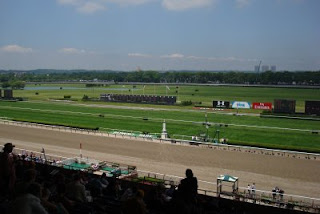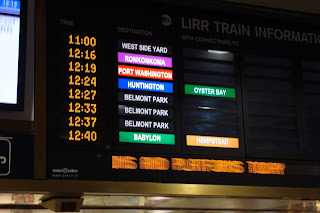Since I am home recuperating from last weekend's (literal) pratfalls I decided to revive a tradition that has kind of been lapsing. A shout out to MC for coming over to witness the carnage. By the way, MC texted me with a Michael Jackson joke a mere scant or so hours after Jacko's death. Just another sick individual! That said, here goes:
1) Left Hand Brewing - 2009 Imperial Oak Aged Stout - 10.2% ABV - Not a Goose Island Bourbon County Stout in its intensity but a very smooth in the middle coffee/chocolate stout. Had to get this in NYC as CT sucks for beer.
2) Legacy Brewing - Euphoria Ale 9.0 A% ABV - watered down Tripel save your money.
Saturday, June 27, 2009
Sunday, June 21, 2009
Saturday, June 13, 2009
Weekend Beer Review!
Decided to start before I go on my afternoon walk which has always proven to be a stupid idea. Well let the tactical error begin!
1) Smuttynose Gravitation - 8.5% Belgian Quad style - Smutty was at the Whole Foods in the Bowery yesterday. I sampled this and decided to buy it. Certainly not a Rochefort 10 but you know what it reminds me of?....A Dogfish Raison De'tre (spelling is optional here). Good beer, just the kind of Rocket Fuel to get me going.
This actually leads me to a couple of subjects:
Dude don't bogart the beer sampling - There was this little beer dweeb who kept yammering away at the guy from Smutty. I was thirsty and just wanted a sample I just finally pushed my way in. Dude no one cares about how many yeast strains that you have heard of. Step aside and let someone else in.
Kelso of Brooklyn shows up at Whole Foods this upcoming Friday. There stuff is not in bottles, but if it's available in Growlers I may pick one up. Interested in growler tips from MC & Adam.
2) Harpoon - The latest in the Leviathan Series Big Bohemian Pilsner - 9% ABV - Another big beer. Tasty, although maybe a bit bitter. Definitely work a try.
1) Smuttynose Gravitation - 8.5% Belgian Quad style - Smutty was at the Whole Foods in the Bowery yesterday. I sampled this and decided to buy it. Certainly not a Rochefort 10 but you know what it reminds me of?....A Dogfish Raison De'tre (spelling is optional here). Good beer, just the kind of Rocket Fuel to get me going.
This actually leads me to a couple of subjects:
Dude don't bogart the beer sampling - There was this little beer dweeb who kept yammering away at the guy from Smutty. I was thirsty and just wanted a sample I just finally pushed my way in. Dude no one cares about how many yeast strains that you have heard of. Step aside and let someone else in.
Kelso of Brooklyn shows up at Whole Foods this upcoming Friday. There stuff is not in bottles, but if it's available in Growlers I may pick one up. Interested in growler tips from MC & Adam.
2) Harpoon - The latest in the Leviathan Series Big Bohemian Pilsner - 9% ABV - Another big beer. Tasty, although maybe a bit bitter. Definitely work a try.
St Paul's Chapel





It must be history day today. But I find this interesting stuff:
History
Trinity Parish completed construction on St. Paul’s Chapel, its second chapel-of-ease, in 1766. Today, St. Paul's Chapel is Manhattan's oldest public building in continuous use, and its only remaining colonial church.
Washington's Pew
George Washington worshiped here on his Inauguration Day, April 30, 1789. During the two years New York City was the country's capital, Washington attended services at St. Paul's while Trinity Church was being rebuilt. Hanging above Washington’s pew is a painting of the Great Seal of the United States (adopted in 1782), which was commissioned by the Vestry in 1785. The artist of the painting is unknown.
Directly across the chapel from Washington’s pew is the Governor's pew. The Arms of the State of New York are depicted in an 18th c. painting on the wall above the pew.
Architecture
St. Paul’s resembles London’s St. Martin in the Fields, and is very likely based on the 1728 pattern book Book of Architecture by James Gibbs. It is constructed of Manhattan mica-schist with brownstone quoins; its woodwork, carving, and door hinges are handmade.
The pulpit is surmounted by a coronet and six feathers. Fourteen cut-glass chandeliers commissioned in 1852 which originally held candles and were later rewired to accommodate electricity hang in the nave and the galleries. The organ case was built in 1804.
On the Broadway side of the chapel's exterior is an oak statue of St. Paul. Below the east window is the monument to General Richard Montgomery, who died at the Battle of Quebec during the American Revolutionary War. This first American monument was commissioned by the Continental Congress in 1776. Benjamin Franklin was directed to secure the execution of the monument in France. Franklin commissioned the prominent French sculptor Jacques Caffieri, who completed the monument in 1779. The monument was installed on the portico of St. Paul’s in 1787. The ornamental design of the "Glory" over the altar is the work of Pierre L'Enfant, who designed Washington, D.C. The "Glory" depicts Mt. Sinai in clouds and lightning, the Hebrew word for "God" in a triangle, and the two tablets of the Law with the Ten Commandments. L’Enfant was asked to camouflage the shadow of the Montgomery Monument in the great window so that it would not distract the worshippers looking toward the altar. L’Enfant carved the “Glory” on the interior, and on the exterior carved iconography showing the birth of a new nation, as depicted by an eagle pulling back the night to expose thirteen rays of the rising sun, juxtaposed with a cherub extinguishing a torch to mourn the fallen hero.
In the spire, the first bell is inscribed "Mears London, Fecit [Made] 1797." The second bell, made in 1866, was added in celebration of the chapel's 100th anniversary.
The Extraordinary Ministry of St. Paul's Chapel
September 2001-May 2002
After the attack on September 11, 2001, which led to the collapse of the twin towers of the World Trade Center, St. Paul's Chapel served as a place of rest and refuge for recovery workers at the WTC site.
For eight months, hundreds of volunteers worked 12 hour shifts around the clock, serving meals, making beds, counseling and praying with fire fighters, construction workers, police and others. Massage therapists, chiropractors, podiatrists and musicians also tended to their needs.
Today, St. Paul's continues as an active part of the Parish of Trinity Church, holding services, weekday concerts, occasional lectures, and providing a shelter for the homeless.
Duane Park


This is a little park that I cut through before the alley.
Now 200 years old, Duane Park is the second oldest public park in New York City. Since 1797, when it was purchased by the city, the park has been redesigned several times. Until 1940, these designs all provided ample greenery. Then the planting area was greatly reduced.
Duane Park was once part of a 62-acre farm outside the limits of the New Amsterdam Settlement. The property was granted to Roeloff and Annetje Jans by Governor Wouter Van Twiller in 1636 and Roeloff Jans was contracted by the West India Company to farm the plot. After Roeloff's death in 1637, Annetje (shown at left) married Everardus Bogardus, the second minister of the Dutch Church of New Amsterdam. The farm was renamed Dominie's Bouwerie. In 1664 the English took over New Amsterdam, and in 1670 Governor Francis Lovelace acquired the farm. Although the Dutch retook New Amsterdam three years later, Jan's heirs did not lay claim to the farm. However, when the English returned in 1674, the Duke of York (who later became King James II) confiscated Lovelace's farm. In 1705, the royal family granted the farm to Trinity Church and it became known as the Trinity's Lower Farm. When Duane Street was laid out in 1794 (it was named after James Duane, a former mayor and the nation's first federal judge) it isolated a triangle of land too small to build on. Three years later the city purchased this remnant of Trinity's Lower Farm to make a park.
In a back alley street
Wednesday, June 10, 2009
And to finish the evening


Went to Rattle & Hum on 33rd St. I really can't stand mid-town & this in my mind might be the only reason to go. I had an Allagash Black on Cask & a 2004 Bigfoot on draft. Nice. There is also a pretty good place heading west on 33rd called Stout which is certainly worth a look. I got a kick out of the pictures I took. Guess which one I liked best!
Monday, June 8, 2009
Sunday, June 7, 2009
Belmont Stakes - Part 2
Friday, June 5, 2009
Subscribe to:
Posts (Atom)

































